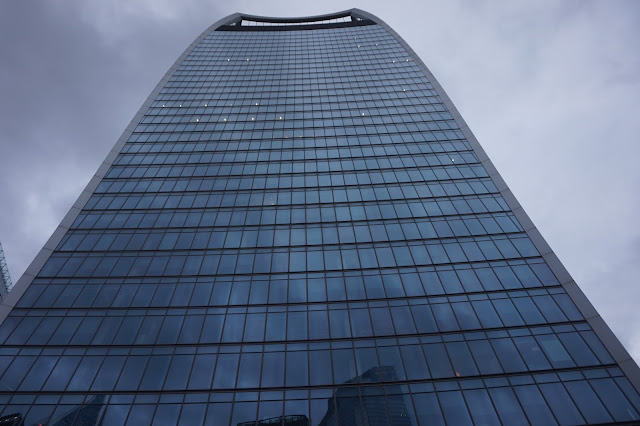I became interested in this building while doing a teaching observation in the classroom one of my colleagues. The topic being introduced that day related to foci of conic sections. Being the great teacher that she is, she began the class by sharing some engaging real-life examples with her students - one of them being this building and it's properties. So . . . other than the fact that it's pretty cool looking, what's so interesting about this building? And what does it have to do with math?
A curved glass surface can reflect the sun's rays in such a way that they are focused on a point and thus concentrated. And that is what happened with this building. The focus was at or near ground level at a nearby street, and the concentrated rays resulted in temperatures at that spot of up to 205 degrees Fahrenheit. Before the parking areas were blocked off with orange cones, a Jaguar was damaged: its side-view mirror being melted by the heat, and a van was damaged: the plastic of the dashboard becoming melted, as well as a bottle that was inside ending up basically baked. Tiles on a storefront in that area were baked to the point of cracking off, and a carpet inside a nearby store started to burn and smoke. As news of this "heat-ray" spread, people turned up with frying pans and were able to fry eggs out on the sidewalk here.
As far as I know, this building doesn't have the shape of a specific conic section that is studied in the classroom. If it had -- for instance, it if were a paraboloid -- the heat intensity at the focus would have been even higher.
I say I've jumped to the 21st century out of my 16th-century posts, but such properties of curved glass or mirrors were actually known even in ancient times. Archimedes used this idea to create his famous "burning mirrors" as a weapon of war to protect Syracuse from the invading Roman troops. Leonardo da Vinci (whom Girolamo Cardano knew) sketched such mirrors as well. And one of "my mathematicians," John Napier wrote of plans for creating such a device at a time when a second Spanish Aramada attack on England and Scotland was feared.
If this has been known about for so long, why did the architect design the building in such a way? Was he not aware of the implications? Well, actually he was aware of this, but he also knew that the sun would only be in the proper position for such concentrations of its rays to take place for 2 to 3 weeks of the year and then only for a couple of hours per day during those weeks. From what I understand, he was also counting on London's notoriously cloudy, foggy, rainy weather to keep this from being an issue. (I've heard he's blaming global warming, but that may just be a rumor.) Responsibility for the issues I've mentioned above has been taken, and those whose vehicles were damaged were reimbursed for repairs.
If you are reading this and have a great deal of familiarity with the building you may have noticed something about the pictures I've posted above that is bothering you. I went on this photo-jaunt not long after arriving in London, and I was not yet oriented to directions here that early on in my trip. As some of you may have noticed, I actually ended up on the wrong side, the north side, which is where all of the pictures above (except the first two) are taken. In my defense, I think my mistake is understandable, not only because of my lack of orientation to the city but because if you look at the two pictures at the top of this post, this building seems to be concave in only one direction. Because what I could see of the building showed it to be concave on the side I was on I thought I was in the right place. But then I walked a bit further and noticed that it is actually concave on both sides. It is more concave to the south, and, of course the south is the side where the sun is going to be more of a problem. The four pictures below show the south side of the building. If the glass looks a bit different it's because they have now fixed the issue by installing aluminum (or, as the British would say, "aluminium") fins. Problem solved!
These two pictures (just above and just below) were taken from the Tower of London. This city has quite a mix of the old and the new, which I find very enjoyable.
I've included two YouTube videos on this topic below. The first is just under 2 minutes long, and the second is just over 4 minutes long. I wanted to share visuals of some of the damage that was done, along with some additional explanation.











No comments:
Post a Comment